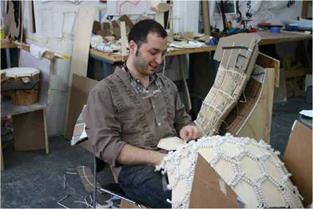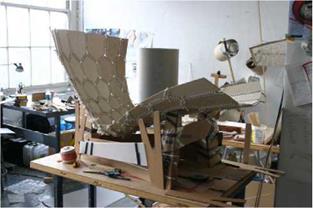Date:
2004
Since 2004, Emiliano Godoy has worked on the design of furniture made with knitted pieces of wood (Figure 4.101). This project started while Godoy was studying industrial design at Pratt Institute in New York. He was researching vegetable-based materials for design, and developing 100 percent biodegradable pieces. The Knit chair was his first attempt to work within these parameters (Figure 4.102). He developed a design language that would speak about the construction of the chair and therefore its deconstruction. From a social-use perspective, the Knit chair is an easy chair in which the user can sit with legs up, crossed, or bent.
The resulting aesthetic of the knitted pieces, as well as its conceptual origin, is compelling. In search for an appropriate solution, Godoy worked mainly in two areas. In order to encourage the correct disposal of the chair, but trying to avoid a visual language that constantly reminds the user of the death of a chair, Godoy incorporated an intermediate step. The construction of the chair speaks about smaller pieces coming together for a bigger structure. The structure is held together by rope, and it breaks apart in smaller elements when those fasteners wear out or become loose. The small pieces can then be put into a compost pile or outdoors so nature can finish the job.
In order to conform to the chosen posture, but using smaller flat pieces, experiments were made with angles and rope sewing. Eventually, the rope was used to provide flexibility in the edges between the smaller pieces, much like a hinge would do, while offsetting the plywood pieces provided the necessary stiffness. It became necessary to design the shape of the individual pieces in a way that the seams would not run in a straight line all across the chair. Research on Arabic tile work, textiles, and especially the work by

|
|
|
M. C. Escher, provided useful insights and inspiration for the final pattern (Figure 4.103). A grid was established in the surface of the shell to receive the pattern. This grid reduces the smaller pieces where the curves are tighter, and expands it where the curves are wider, in a similar way to fish or reptile’s scales.
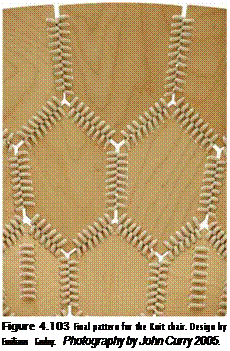 The final aesthetics of the chair are a result of the outline and contour
The final aesthetics of the chair are a result of the outline and contour
of the shell, defined around the chosen posture in a way that it is easy to understand how the chair is appropriate for such use. The individual pieces speak about the structure and flexibility of the chair, while not becoming a graphic feature that dominates its overall message and perception (Figures 4.104 and 4.105).
Prototype’s materials: 3.2-mm aircraft-grade plywood, FSC certified; and 3/16-inch cotton rope. The finish applied to the plywood is carnauba wax. Overall dimensions are 55 x 34 x 37Уг inches (140 x 87 x 95 cm).
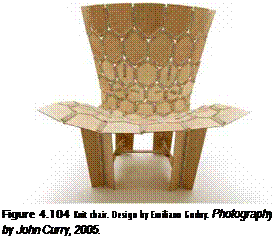 Sustainability has always been an ethical commitment for Godoy. Biomass is the primary source for material. Biomass is produced by living organisms that are tightly related to nature’s life-supporting cycles, and its use within sustainable parameters set the pace for industrial activity. Technological materials would be saved for applications where no biological material performs adequately, and their availability would be guaranteed for a longer period of time. Fewer regulatory and certification entities will be needed if capital production and waste recycling depends on efficient natural cycles, since industrial activities would rely on healthy ecosystems for their energy and materials supply.
Sustainability has always been an ethical commitment for Godoy. Biomass is the primary source for material. Biomass is produced by living organisms that are tightly related to nature’s life-supporting cycles, and its use within sustainable parameters set the pace for industrial activity. Technological materials would be saved for applications where no biological material performs adequately, and their availability would be guaranteed for a longer period of time. Fewer regulatory and certification entities will be needed if capital production and waste recycling depends on efficient natural cycles, since industrial activities would rely on healthy ecosystems for their energy and materials supply.
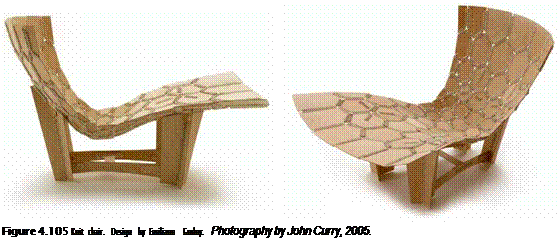 |
The knitted pieces have another philosophical aspect, which is the fact that they cannot be machine made—they depend on hand work. This means that the payment for the pieces goes primarily to labor instead of tooling amortization, and that their particular aesthetic depends on this. By adding other social and environmental strategies, such as fair labor practices, certified wood, and ecological glues and finishes, the pieces become very strong statements about sustainable design (Figure 4.106).
Figure 4.106 Knit chair. Design by Emiliano Godoy. Photography by John Curry, 2005.
|
Furniture: |
Araneae coffee table |
|
Designer: |
Greg Lewis, Pleat Design |
|
Company: |
Furniture Design Ideas © 2021
Frontier Theme
|

